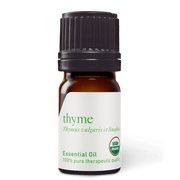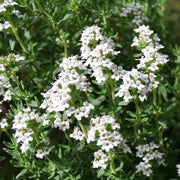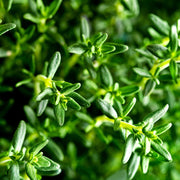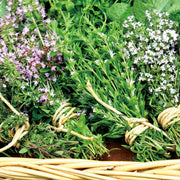Which thyme essential oil?
Did you know it’s not possible to buy plain “thyme” oil? That’s because the thyme plant can produce different variations of its thyme oil. These are called essential oil chemotypes.
Two thyme plants can have the exact same genus and species—Thymus vulgaris—yet produce dramatically different thyme essential oils. (Nature is amazing!)
What is thyme?
First, lets talk about what thyme is. Then we will get into how to best use some of the most popular variations of thyme oil.
Thyme is an aromatic herb, a member of the mint family, that is widely used in aromatherapy due to its strong and invigorating aroma. Thyme oil is extracted from the plant and is known for its antibacterial and antiseptic properties.

Thyme ct linalool plants
Thyme has been used for centuries in aromatherapy and traditional medicine due to its antimicrobial and aromatic properties. The ancient Egyptians and ancient Greeks used thyme in their baths, incense, and as a natural remedy for various ailments, including respiratory issues, digestive system problems, and wounds.
Today it is often used in aromatherapy to help alleviate respiratory issues, such as congestion and coughing. Thyme oil is also believed to have therapeutic benefits for the mind and body, with some studies suggesting that it may help improve mood, boost mental clarity, and reduce stress levels. Thyme oil can be used in a variety of ways, including in diffusers, inhalers, massage oils, and bath salts. Its herbaceous and slightly spicy scent is a popular choice for those seeking a natural and effective way to promote overall wellness and relaxation.

English Thyme plants in bloom
Thyme oil can be affected by chemotypes, which refer to the different chemical compositions of the thyme oil depending on the species and variety of the thyme plant. Chemotypes can result in variations in the aroma, potency, and therapeutic properties of thyme oil, which can affect its effectiveness in aromatherapy and other benefits. It is important to choose the correct chemotype of thyme oil based on its intended use to ensure optimal results.
What are essential oil chemotypes?
Have you ever seen the letters “ct” on your essential oil label and wondered what it means?
These two little letters have a dramatic impact on your blends!
When a plant produces variations in its essential oil—as thyme does—the letters “ct” tell you which chemical type of the oil you have, also known as its “chemotype.”
Factors such as moisture, temperature, the region the plants grow in, and the amount of sunlight they get all affect the chemical composition of oil that thyme produces. Each type contains a different cocktail of natural chemical components. These components are the molecules that literally make up thyme oil. You can think of them as the oil’s “ingredients.”

How do we know what components are present in an essential oil? A GC/MS test tells us!
GC/MS stands for “Gas Chromatography/Mass Spectrometry.” It’s a laboratory test. You can think of it like purity testing. Not only does a GC/MS test verify an oil’s purity, it also identifies the individual components present in the oil.
When we look at the list of components for a bottle of thyme essential oil, we can see which are more prevalent. This tells us which chemotype of thyme oil is in the bottle.
Thymus vulgaris actually produces six common chemotypes: oils rich in thymol, linalool, carvacrol, geraniol, a-terpineol, and thuyanol.
In this post, we’ll explore two of the most popular of thyme essential oil: thymol and linalool
Thyme oil chemistry: thymol vs linalool!

Thymol is a super-strong, potent component. It has powerful actions (especially against germs), but can irritate skin and mucous membranes.
Linalool is an ultra-gentle component. It can relax the mind, calm stress, and soothe your entire system holistically.
Understanding these two chief constituents of this medicinal herb will allow you to take advantage of its health benefits.
Thymus vulgaris ct thymol

While both chemotypes of thyme are useful for reducing germs (and fungi) and for boosting immunity, thyme ct thymol essential oil is more appropriate for acute, short-term use.
The component thymol can be harsh on skin and mucous membranes. Use thyme ct thymol essential oil sparingly in topical blends and inhalers. We suggest a 1% dilution (5 to 6 drops of essential oil per 1 oz/30 ml of carrier oil such as jojoba oil). The thymol content adds a robust kick to short-term blends for issues like strengthening immunity during cold season, or soothing itchy feet.
If you don’t have an acute, urgent need for thyme ct thymol’s strength, you can use it in plenty of blends where its potent touch won’t irritate sensitive skin or noses.
Try it in blends for natural cleaning, diffuser blends to purify your indoor air, and mists to support your breath.
Use thyme ct thymol oil to:
- Clean your home with natural antibacterial properties
- Purify indoor air of unpleasant odors
- Massage achy muscles & joints
- Boost your immune system
- Open your respiratory system

Thyme ct Thymol Oil (Thymus vulgaris ct thymol)
Thyme ct. thymol essential oil has a warm herbal aroma that’s sharper than the linalool chemotype of thyme. This emboldening oil can help restore the body’s strength and health, activating an indomitable will that can accomplish anything. Like the other chemotypes of thyme, it has no patience for germs—however, this variety is so potent that it should be diluted well in topical blends. Our certified organic thyme ct. thymol oil is steam distilled from the flowers and leaves of herbs grown in southern Europe in rural, sunny Spanish fields.
Thyme ct Thymol Essential Oil Recipes:
Thymus vulgaris ct linalool

Thyme ct linalool is the gentler chemotype of the two thyme oils. It’s still an excellent purifying oil, and is appropriate for long-term use.
Linalool is famous for soothing skin, so there’s less concern of irritation with this chemotype. Thyme ct linalool is ideal for acne care, and for comforting small cuts or scrapes (after washing them with soap and water). It is an excellent essential oil for reducing inflammation, dealing with open sores, and calming anxiety.
Linalool is also one of the main components in lavender essential oil (and several other relaxing oils), and it makes thyme ct linalool a softer, comforting choice when you’re not in need of acute support. Choose thyme ct linalool for purifying topical blends, such as all natural immune-boosting hand lotion, or for personal inhalers that won’t irritate the inside of your nose. It’s also helpful in blends to calm stress.
Use Thyme ct Linalool Oil to:
- Purify acne-prone skin
- Soothe anxious feelings
- Comfort sore, damaged skin
- Ward off the common cold
- Open your breath
Thyme ct Linalool Oil (Thymus vulgaris ct linalool)
Herbal, fresh, and sweet, thyme ct. linalool’s aroma is softer and woodier than thyme ct. thymol. With its soothing scent and gentle touch, this variety of thyme can help cleanse germs while treating skin and mucous membranes tenderly. “Linalool” is a component that helps make lavender relaxing, so turn to thyme ct. linalool to inspire a calm heart as it secures your health. Our certified organic thyme ct. linalool essential oil is created through steam distillation of the flowers and leaves of herbs cultivated in bright, sunny fields in the Spanish countryside.
Thyme ct Linalool Recipes:
Another Variety to Consider: Thyme (Benchmark) Essential Oil
While this blog focuses on the thymol and linalool chemotypes of thyme, it’s worth mentioning another potent variety: Benchmark Thyme Essential Oil. Unlike thymol and linalool, which come from Thymus vulgaris, Benchmark Thyme is a blend of four species of Thymus zygis. This unique combination offers a robust defense against germ-based threats, while also providing a skin-friendly aspect. Its warm, herbal aroma, with spicy and camphor-like notes, makes it a versatile choice for both cleaning blends and topical applications.
Although not a direct chemotype comparison like thymol or linalool, Benchmark Thyme is an excellent alternative when you need a balance between strength and gentleness, making it suitable for long-term use.
Use Benchmark Thyme Essential Oil to:
- Clean and purify naturally
- Soothe sore muscles and joints
- Boost immunity
- Enhance respiratory health
Thyme Benchmark Essential Oil recipes:
Pay Attention to the Details!
In an oil’s Latin name, its chemotype is shown with the letters “ct.” This is why it’s important to purchase your essential oils from a company that provides detailed information like the Latin name and chemotype to ensure you’re getting the right oil for your needs.
Learn more about essential oils
Thyme ct thymol is one of our top 10 essential oils for natural cleaning!
See the full list—and get a complete guide to cleaning your entire home without harmful chemicals—in Going green at home: natural cleaning with essential oils. You’ll learn why green cleaning is important for your family’s immune system, how to be safe while making and using your own products, and recipes you can start making today.
















